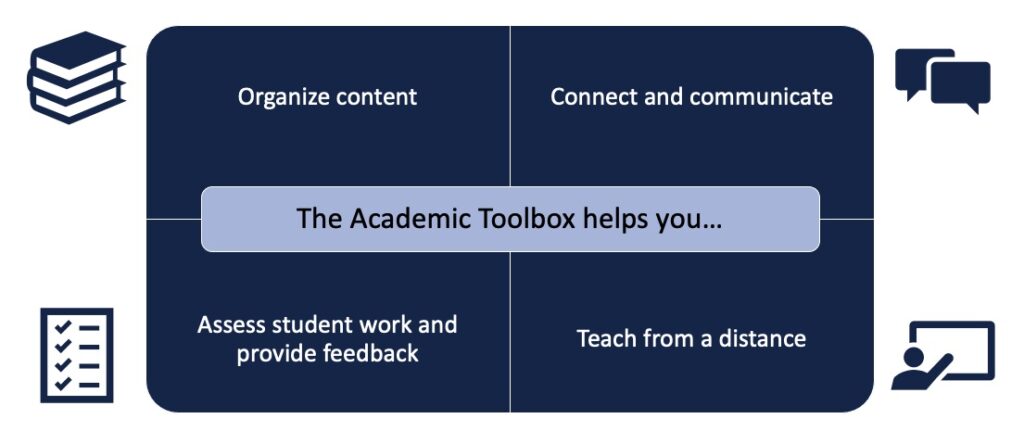Library Reading List

The Library Reading List application manages course reserves material reserved through the University of Toronto Library’s Course Reserve and Syllabus Service System. This tool creates a single list of all the course materials you have requested for your class through the Library’s Course Reserves and Syllabus Service.
If you are using this service, it is recommended to add the Library Reading List navigation link to your Course Navigation menu. See more information on adding the navigation link.
This Library Reading List tool creates a list of all the course materials which is integrated into a Quercus course shell. It combines electronic articles, ebooks, streaming media, print books, and scanned PDFs into a single comprehensive list that is easy to use. Students will be able to access their course lists through the Library Course Reading List application.
In addition, instructors can set aside – i.e., ‘reserve’ – physical items such as books and DVDs in the Course Reserves/Short Term Loan sections of various libraries at U of T for borrowing.
The Academic Toolbox helps you...
The tools in your Quercus Academic Toolbox can assist with your course delivery by Organizing Content, helping you Connect and communicate with your students, Assessing student work and providing feedback, and allowing you to Teach from a distance.
Typical Course Format?
Most tools in the Academic Toolbox can assist in both online and face-to-face courses. Many tools can provide benefits in either synchronous or asynchronous teaching. Some tools have been primarily designed for one format or another (synchronous/asynchronous), however, may be adapted for any format depending on your pedagogical goals.
To learn more about different teaching modalities, please consult our Online Teaching & Learning page, arrange a consultation with a CTSI Teaching Liason, or contact your Divisional support representative.
Where can I get more support?
Related resources / similar tools
Instructions
-
Instructors can request material for their courses by submitting readings lists to the Library. Please consult the Course Readings and Reserves Support
 page for instructions.
page for instructions. -
Add Library Reading List Application
to Your CourseAfter readings are added, library staff will notify you when the reading list is complete and provide instructions on adding the Library Reading List application to your Quercus course page.
Add the Library Reading List navigation link so that it appears in your Course Navigation menu in Quercus. The Navigation Link can be found and added to your course by the following steps:
- In your course menu, select “Settings” (at the bottom left corner).
- Select the “Navigation” tab (located at the top of the screen).
- Select and drag “Library Reading List” up from the list of hidden navigation items to the list of visible navigation items in the top half of this list. Place it where you would like it to appear in the Course Navigation menu.
- Save your change.
Students, teaching assistants, and instructors will now have access to the Library Reading List.
See Library Reading List in Quercus
 for more information.
for more information. -
Accessing Readings in the Library Reading List Application
The reading list will only appear for enrolled students and for a particular instance of a course.
Students and instructors can access a course’s reading list via the Library Reading List application within a Quercus course site’s navigation bar. Selecting this causes the reading list associated with the course to be displayed once library staff have created the list.
To enlarge your view, select the small icon (box with arrow) in the top right corner of the screen to open the application in a new tab within your window.
-
Uploading material to Quercus on your own?
If you are adding readings to Quercus yourself, review copyright resources
 for guidance. Upon request, the library will email you the PDF files of scanned journal articles or book chapters for you to post in Quercus.
for guidance. Upon request, the library will email you the PDF files of scanned journal articles or book chapters for you to post in Quercus.
Guides
-
University of Toronto Libraries – Course Readings and Reserve Support- https://onesearch.library.utoronto.ca/copyright/course-readings-and-reserves-support
Videos
-
Watch the University of Toronto Libraries’ Scholarly Communications and Copyright Office’s “Navigating the Library Reading List App” video (09:11, UTORid login required). Select “CC” for closed captions.
-
Overview of the Library Reading List tool (02:35). Select “CC” for closed captions.
Last Modified:
4 December, 2025
This work is licensed under a Creative Commons BY-NC-SA 4.0 International License
